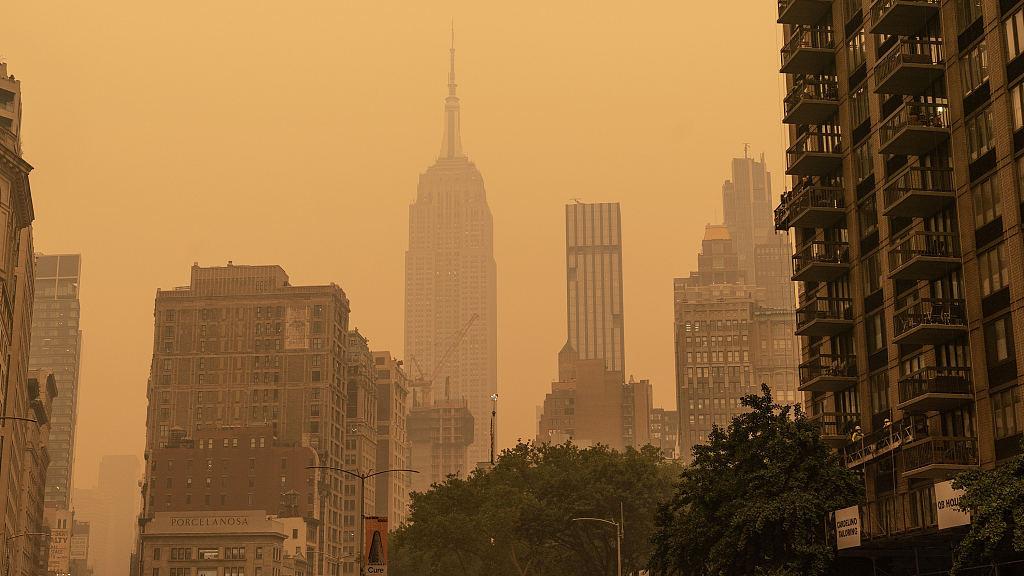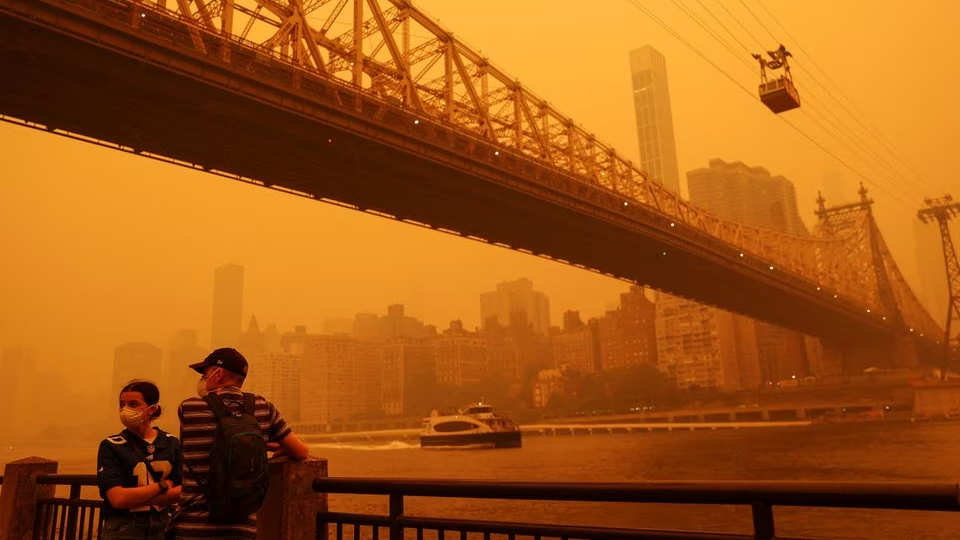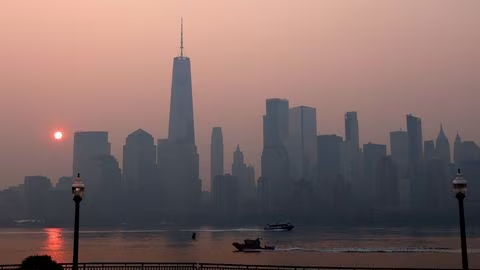
View of hazy New York City during bad air quality with smoke of Canadian wildfires brought in by wind, June 7, 2023. /CFP
View of hazy New York City during bad air quality with smoke of Canadian wildfires brought in by wind, June 7, 2023. /CFP
Massive fires are burning up stretches of Canadian forests and sending plumes of smoke into the U.S.
On Wednesday afternoon, New York city had the highest Air Quality Index (AQI) in the world at 342, about double the index for chronically polluted cities such as Dubai (168) and Delhi (164), data from an air quality technology company showed.
The smoke sent asthma sufferers to hospitals, delayed flights and postponed ballgames afterwards, and health authorities have raised the alarm about poor air quality.
Read more: Canada wildfires continue as smoke shrouds large parts of U.S.
What is contained in wildfire smoke?
More toxic than normal air pollution, wildfire smoke can linger in the air for weeks and travel hundreds of miles.
Wildfires can burn not only vegetative materials and trees, but also cities, destroying vehicles and buildings and their content.
Along with particles of soil and biological materials, wildfire smoke often contains traces of chemicals, metals, plastics and other synthetic materials.

A man wears a mask while riding a bicycle in New York City, U.S., June 7, 2023. /CFP
A man wears a mask while riding a bicycle in New York City, U.S., June 7, 2023. /CFP

People wear protective masks as the Roosevelt Island Tram crosses the East River while haze and smoke from the Canadian wildfires shroud the Manhattan skyline, June 7, 2023. /Reuters
People wear protective masks as the Roosevelt Island Tram crosses the East River while haze and smoke from the Canadian wildfires shroud the Manhattan skyline, June 7, 2023. /Reuters

The One World Trade Center tower in lower Manhattan in New York City is pictured shortly after sunrise as haze and smoke caused by wildfires in Canada hangs over the Manhattan skyline in as seen from Jersey City, New Jersey, U.S., June 8, 2023. /Reuters
The One World Trade Center tower in lower Manhattan in New York City is pictured shortly after sunrise as haze and smoke caused by wildfires in Canada hangs over the Manhattan skyline in as seen from Jersey City, New Jersey, U.S., June 8, 2023. /Reuters
What are the known health effects?
In laboratory experiments, a given amount of wildfire smoke causes more inflammation and tissue damage than the same amount of air pollution, according to Kent Pinkerton, co-director of the Center for Health and the Environment at the University of California, Davis.
Studies in people have linked wildfire smoke with higher rates of heart attacks, strokes, and cardiac arrests, increases in emergency room visits for respiratory conditions, and weakened immune defenses. Wildfires have also been linked with eye irritation and skin problems.
The effects of exposure can persist for years. After Australia's 2014 Hazelwood Coal Mine fire, rates of heart disease remained elevated for two and a half years and respiratory illnesses for five years, researchers reported in April.
Wildfire exposure in pregnancy has been associated with pregnancy loss, low birth weight and preterm delivery. A study from California that has yet to be peer reviewed found a link between wildfire exposure and cellular damage in first- and second-trimester placentas.
Canadian researchers have reported that people who lived outside of major cities and within 50 kilometers of a wildfire in the past decade had a 4.9 percent higher risk of lung cancer and a 10 percent higher risk of brain tumors compared to people not exposed to wildfire.
Exposure to the 2018 Camp Fire in California was linked to changes in cognition and brain activity six to 12 months later, possibly related to stress and trauma, according to California researchers.
New data from California also shows an increase in fungal infections in the months following wildfire smoke exposure, likely due to fungal spores in the smoke.
What can help mitigate the risks?
Experts say it is best to limit outdoor activities, especially strenuous sports, and to wear N95 masks.
On average, when you are indoors, the concentration of wildfire pollutants is about half of what it is outdoors, according to Dr. Jasvinder Singh, a lung medicine specialist at Medstar Franklin Square Medical Center in Baltimore.
If a building is not well sealed, the concentration may be up to 70% of what it is outside, he said.
The U.S. Environmental Protection Agency advises that during wildfire smoke events, people avoid indoor activities that put more fine particles into the air, such as smoking cigarettes, frying or broiling food, burning candles or incense, and vacuuming without a HEPA filter.
Read more: Smoke from Canadian wildfires sets off health alerts in New York, Ottawa
(With input from agencies)